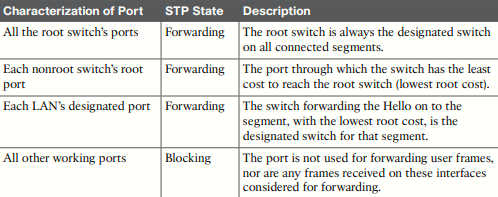RSTP theory (pending completion with NetAcad theory)
Three classes of problems caused by not using STP in redundant LANS:
- Broadcast storm: The forwarding of a frame repeatedly on the same links, consuming significant parts of the links' capacities.
- MAC table instability: The continual updating of a switch's MAC address table with incorrect entries, in reaction to looping frames, resulting in frames being sent to the wrong locations.
- Multiple frame transmission: A side effect of looping frames in which multiple copies of one frame are delivered to the intended host, confusing the host.
RSTP uses three criteria to choose whether to put an interface in forwarding state:
- RSTP elects a root switch. RSTP puts all working interfaces on the root switch in forwarding state.
- Each nonroot switch considers one of its ports to have the least administrative cost between itself and the root switch. The root cost is called that switch's root cost. RSTP places its port that is part of the least root cost path, called that switch's root port (RP), in forwarding state.
- Many switches can attach to the same Ethernet segment, but due to the fact that links connect two devices, a link would have at most two switches. With two switches on a link, the switch with the lowest root cost, as compared with the other switches attached to the same link, is placed in forwarding state. That switch is the designated switch, and that switch's interface, attached to that segment, is called the designated port (DP).
All the root switches' working interfaces will forward frames.
RSTP only considers working interfaces (those in a connected state). Failed interfaces (i.e. with no cable installed) or shutdown interfaces are instead placed into a discarding state.


